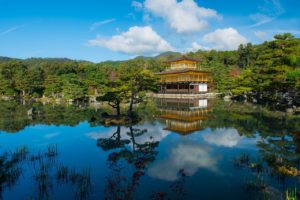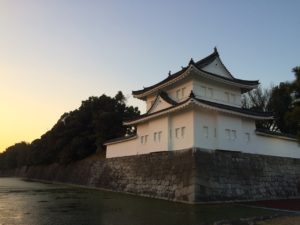
OPTION 1: Full Day Kyoto Highlights Tour
Today your knowledgeable private guide will pick you up at the hotel to explore the former imperial capital, utilizing Kyoto’s comprehensive bus system to visit some of Kyoto’s World Heritage Sites. You will start your day with a visit to Kinkakuji Temple (Golden Pavilion), which was originally built as a retirement villa for the Shogun. After his death it became a Buddhist Temple at his request and is now one of Kyoto’s most famous temples. Completely covered in gold leaf, it creates a shimmering view that is impossible to forget.
Nijo Castle is an ornamental castle built by the founder of the Edo Shogunate as his Kyoto residence and is surrounded by stunning surrounding gardens. The main building was completed in 1603, and is famous for its architecture, decorated sliding doors and ‘chirping’ nightingale floors.
Take a walk down Nishiki Market, a narrow, five block long shopping street lined by more than one hundred shops and restaurants. Known as “Kyoto’s Kitchen”, this lively retail market specializes in all things food related, like fresh seafood, produce, knives and cookware, and is a great place to find seasonal foods and Kyoto specialties, such as Japanese sweets, pickles, dried seafood and sushi.
To end the day, you can decide what to visit:
– You may want to go to Kiyomizu (Pure Water) Temple.
From the 13m high veranda jutting out from the Main Hall you can enjoy amazing views of the whole of Kyoto, whilst pondering the fact that both the Main Hall and Veranda were built without the use of nails or any kind of joiners; however, it is a steep walk uphill, and the temple is now under repair work, although it is still enjoyable and a Kyoto landmark.
– You may decide, instead, to visit Sanjusangendo, a temple which is Japan’s longest wooden structure (120m).
It is famous for its 1001 statues of Kannon, the goddess of mercy. In the center of the main hall sits a large, wooden statue of a 1000-armed Kannon that is flanked on each side by 500 statues of human sized 1000-armed Kannon standing in ten rows. Together they make for an awesome sight.
During low season this tour will be done by public transport. During high season this tour will be done by taxi due to busses being very crowded. All Tickets and entrances are included.
Duration: 8 hours
*Note: If Nijo Castle is closed (due to its own availability), Ryoanji temple will be visited instead.
OPTION 2 : Half Day Kyoto Highlights Tour
Start the day with a visit to Kinkakuji Temple (Golden Pavilion), which was originally built as a retirement villa for the Shogun. After his death it became a Buddhist Temple at his request, and is now one of Kyoto’s most famous temples. Completely covered in gold leaf, it creates a shimmering view that is impossible to forget.
Next is Nijo Castle, an ornamental castle that was built by the founder of the Edo Shogunate as his Kyoto residence and is surrounded by stunning surrounding gardens. The main building was completed in 1603, and is famous for its architecture, decorated sliding doors and ‘chirping’ nightingale floors. Finish the day with a visit to Nishiki Market. Known as “Kyoto’s Kitchen”, Nishiki is a narrow shopping street lined more than 100 shops, selling fresh seafood and vegetables, pickles, Japanese sweets and sushi.
Your guide will pick you up from your hotel. During low season this tour will be done by public transport. During high season this tour will be done by taxi due to busses being very crowded. The tour disbands in Nishiki area. Possibility to hire a driver upon request.
Duration: 4 hours






